Victor I. Kolobov, Katrine Golubkov, Juan Ramón Muñoz de Nova, and Jeff Steinhauer
We confirm the stationary character of the spontaneous Hawking radiation in an analogue black hole. Furthermore, we follow the time evolution of the Hawking radiation and compare and contrast it with the predictions for real black holes. We observe the ramp up of the Hawking radiation, similar to a real black hole. The end of the spontaneous Hawking radiation is marked by the formation of an inner horizon. The Maryland group predicted that particles emanating from the inner horizon can cause stimulated Hawking radiation. We find that these stimulated Hawking pairs are directly observable.
For the full article click here

The blue light emanates from the location of the sonic black hole. This light creates the sonic horizon.
